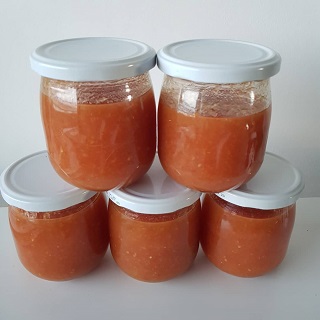Hi,
my Mum has always made tomato sauce or juice for winter preserves. This has been one of the most important late summer activities. We wouldn´t buy tomato sauce or juice, instead we would bottle our own. We would usually call this preserve by the name of the fruit – tomato. Here is the recipe for it. It´s simple, but does take time to finish.
Needed for Tomato juice
Tomatoes
That´s it. Just tomatoes and time. Nothing else. We don´t put any salt in. nor water. You can keep water handy in case you over reduce them.
Procedure
With such an amazing ingredient there is a bit of procedure to follow in order to get the best results. The procedure to make and bottle the juice has 3 steps:
- Clean, cut and cook tomatoes
- Puree or mill the tomatoes
- Reduce the tomatoes
- Bottle the tomatoes
So without further ado let´s start with our tomato juice.
1 Clean, cut and cook tomatoes
First wash all of your tomatoes to remove any dust. Then take a cold big pot and start cutting your tomatoes. As you cut a tomato in 3-4 pieces add it to your pot.
Make sure your pot is cold.
Do NOT put your pot over the heat until ALL of the tomatoes are sliced.
Mum
Follow Mum´s instructions – first cut all of your tomatoes, then put them over medium heat. Let the pot slowly come to temperature, as it heats up the tomatoes will heat slowly up as well and let out their juice. It will take about an hour for all of the tomatoes to cook through. But they will be done once when all of their skins have curled up and are easy to pull away from the slices.
2 Mill or puree the tomatoes
Now comes the messy part. Our tomatoes are cooked but to make the huice we still need to liquify them. The usual procedure is to use a food mill and mill them using a grater with small enough holes so that the tomato seeds don’t go through mill. When you are finished with milling a batch all that should be left in the food mill should be tomato skins and seeds.
If you don’t have the food mill, but have a good blender you can just as easily blend them up. For this you need to let them cool, otherwise you might have an exploding tomato situation (last explosive event in my kitchen was with a beet puree. I am still cleaning the beets up form the quirky corners – not fun).
3 Reduce the tomatoes
Now we have to cook the tomatoes once again to reduce them to your liking. It is not important to cook them for an extra long time, but they need to be boiling for at least 10 minutes in order to pasteurise them. I slowly boiled them for some 20 minutes, to get the to the consistency I liked. And than I was ready for the next step.
4 Bottle the tomatoes
Now that our tomato juice is to our liking, we will bottle it. It needs to be boiled while still hot into the already hot bottles or jars. I would stick my jars into the oven on 100ºC to heat them up and then take them out one by one. As I fill in one jar, I put the lid on and put it into a basked or box that is heavily lined with blankets. Then when the entire box is filled, I put a thick layer of blankets on top and leave it to rest for at least 24 hours. When the jars are finally cold, I put them to storage area. This way my tomato juice is shelf stable. If you open a jar, make sure to finish it as soon as possible, but you can keep it in fridge up to one week.
I hope you give this tomato recipe a try. It is a beautiful and tasty way to keep your tomato harvest for winter months.

